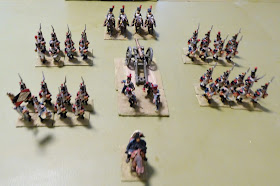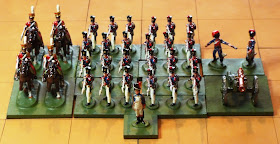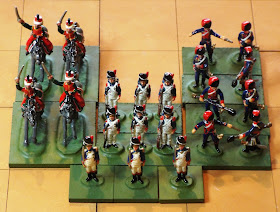I've long been an admirer of Thistlebarrow/Paul Leniston's NAPOLEONIC WARGAMING blog, and particularly the way he has maintained a tempo of fighting weekly battles as part of his ongoing Napoleonic campaign.
Over the past few weeks he has been writing about how he organises his figures into armies, and after a recent blog entry about the French Imperial Guard, I exchanged a number of messages with him. The upshot of this is my decision to get some of my figures onto my tabletop to see if I could organise them in a similar way.
(Please note, I wrote similar and not the same. As Thistlebarrow/Paul Leniston pointed out in one of his messages, one should tailor ones wargame army organisation to what one has available, both in terms of figures and space. It should also reflect a reasonable balance between the strengths of the three arms deployed on the tabletop. I have used the same terms as Thistlebarrow/Paul Leniston has on their blog so that readers can compare the two.)
Imperial Old Guard Corps
As can be seen, this Corps comprises:
Imperial New Guard Corps
As can be seen, this Corps comprises:
Imperial Guard Reserve Corps
As can be seen, this Reserve Corps comprises:
(I still have some Imperial Guard figures that I have yet to renovate. These include another two bases of Imperial Guard Lancers and two bases of what I think are Imperial Italian Guard Foot Grenadiers.)
Napoleonic Corps Organisation Chart
When looked at as an organisation chart, my Corps organisation looks like this:
I rather like the look of this Corp structure, and I could use it with the various versions of THE PORTABLE NAPOLEONIC WARGAME without any problems.
Doing this exercise has made me realise that I really ought to finish renovating my collection of Napoleonic figures over the next year or so in order to get them onto my tabletop and fighting some battles. Perhaps one way to achieve this is to try to set myself a goal of renovating twenty or so figures per month. This would certainly put a dent in the pile of figures awaiting renovation without turning the project into an obsession.
Regular blog readers might have noticed that I set my various Imperial Guard Corps out on my recently painted 50mm squared PORTABLE WARGAME board from Warbases. This was not done by accident. My earliest attempts at writing a set of Napoleonic wargame rules used single-base units on a 50mm squared tabletop. (It was a 15 x 15 grid, which is somewhat larger than my new board.)
I wanted to see what my Thistlebarrow/Paul Leniston-inspired Corps looked like on a similar tabletop, and it struck me that by halving the size of a Corps (i.e. using 4 bases of infantry, 1 base of cavalry, 1 base of artillery [plus a gun], and an officer), I could fit two small armies onto my new 50mm squared PORTABLE WARGAME board from Warbases without too many problems.
Please note that the top two photographs featured above are © Thistlebarrow/Paul Leniston.
Over the past few weeks he has been writing about how he organises his figures into armies, and after a recent blog entry about the French Imperial Guard, I exchanged a number of messages with him. The upshot of this is my decision to get some of my figures onto my tabletop to see if I could organise them in a similar way.
Above: Thistlebarrow/Paul Leniston's French Imperial Old Guard Corps.
Below: Thistlebarrow/Paul Leniston's French Imperial New Guard Corps.
(Please note, I wrote similar and not the same. As Thistlebarrow/Paul Leniston pointed out in one of his messages, one should tailor ones wargame army organisation to what one has available, both in terms of figures and space. It should also reflect a reasonable balance between the strengths of the three arms deployed on the tabletop. I have used the same terms as Thistlebarrow/Paul Leniston has on their blog so that readers can compare the two.)
Imperial Old Guard Corps
As can be seen, this Corps comprises:
- 4 bases of Imperial Guard Foot Grenadiers
- 4 bases of Imperial Guard Foot Chasseurs
- 2 bases of Imperial Guard Horse Grenadiers
- 1 base of Imperial Guard Horse Artillery (with gun)
- An officer on foot
Imperial New Guard Corps
As can be seen, this Corps comprises:
- 4 bases of Imperial Guard Fusilier-Grenadiers
- 4 bases of Imperial Guard Fusilier-Chasseurs
- 2 bases of Imperial Guard Lancers
- 1 base of Imperial Guard Horse Artillery (with gun)
- An officer on foot
Imperial Guard Reserve Corps
As can be seen, this Reserve Corps comprises:
- 2 bases of Imperial Guard Foot Grenadiers
- 2 bases of Imperial Guard Mamelukes
- 4 bases of Imperial Guard Horse Artillery (without guns)
(I still have some Imperial Guard figures that I have yet to renovate. These include another two bases of Imperial Guard Lancers and two bases of what I think are Imperial Italian Guard Foot Grenadiers.)
Napoleonic Corps Organisation Chart
When looked at as an organisation chart, my Corps organisation looks like this:
I rather like the look of this Corp structure, and I could use it with the various versions of THE PORTABLE NAPOLEONIC WARGAME without any problems.
Doing this exercise has made me realise that I really ought to finish renovating my collection of Napoleonic figures over the next year or so in order to get them onto my tabletop and fighting some battles. Perhaps one way to achieve this is to try to set myself a goal of renovating twenty or so figures per month. This would certainly put a dent in the pile of figures awaiting renovation without turning the project into an obsession.
Regular blog readers might have noticed that I set my various Imperial Guard Corps out on my recently painted 50mm squared PORTABLE WARGAME board from Warbases. This was not done by accident. My earliest attempts at writing a set of Napoleonic wargame rules used single-base units on a 50mm squared tabletop. (It was a 15 x 15 grid, which is somewhat larger than my new board.)
I wanted to see what my Thistlebarrow/Paul Leniston-inspired Corps looked like on a similar tabletop, and it struck me that by halving the size of a Corps (i.e. using 4 bases of infantry, 1 base of cavalry, 1 base of artillery [plus a gun], and an officer), I could fit two small armies onto my new 50mm squared PORTABLE WARGAME board from Warbases without too many problems.
Please note that the top two photographs featured above are © Thistlebarrow/Paul Leniston.






Nice to see how you've approached organising your units. I have little knowledge of this period, so this has been useful:).
ReplyDeleteSteve J.,
DeleteI am a bit of a novice myself, which is why I've drawn so heavily upon Thistlebarrow/Paul Leniston. He is a far, far more experienced Napoleonic wargamer than I am.
All the best,
Bob
An army Re-Org is a perfect solution to re-establishing project motivation.
ReplyDeleteJonathan Freitag,
DeleteGetting some toy soldiers out of their boxes and pushing them around on the tabletop does tend to get the old wargaming juices flowing ... and as you will see from my next blog entry, I've not confined myself just to my Napoleonic collection.
All the best,
Bob
Hi Bob
ReplyDeleteSorry it has taken me so long to comment, but I have just returned from two weeks holiday in the UK.
I am really pleased that you are experimenting with an order of battle similar to my own. As far as I know no one else has done so, and I will be really interested to see how it develops. In particular I will be interested in how the game feels when you play it with your own rules. There should be on problem, but who can tell.
To my eye your orbat looks great, but then again of course it would!
I will also be interest to see what your many followers think of the project.
best regards
Paul
Thistlebarrow (Paul),
DeleteI hope that you enjoyed your break in the UK.
Playing around with the ORBATs for my Napoleonic figures has given me all sorts of ideas, and not just for that collection.
The response from my regular blog readers was positive, and I suspect that several of them will adopt something similar.
All the best,
Bob
In my view, Bob, yours (and 'Thistlebarrow's) organisations would go very well with your PNW game set. It is not far different from the sort of organisation you suggested for Army Corps level actions. Paul does add some dimensions, though, e.g. with the addition of skirmishing factors into the game.
ReplyDeleteI also think that 3 or 4 of the 'Thistlebarrow Army Corps' would 'fit' quite well on a much smaller table than what he uses. Such would be my hope, at any rate: my biggest table surface is 6'x4' - and that is a beggar to set up, and awkward when set up.
On the matter of cavalry organisations, I attach only light cavalry to Army Corps (chasseurs, lancers or hussars), whilst the heavies (and mediums, if dragoons are placed as an 'in between' class) I retain for separate Cavalry Corps. Of course, their primary function is the 'masse de rupture' - the hammer blow to smash through a weakened part of the enemy line. One of these days I'd love to see my 36 French cuirassier figures (a single Corps of 3x12-figure brigades) in a massed charge against an exiguous enemy centre...
For my own BE4ST game set (the which I REALLY MUST find time to play around with and update) I don't have any formal subdivisions below Infantry Division and Cavalry Brigade, but between you and 'Thistlebarrow', my resolve there is weakening.
Cheers,
Ion
Archduke Piccolo (Ion),
DeleteI certainly think that this sort of organisation will work with my PNW rules in particular, and I am planning to go into this in more depth after COW. I'm also looking to develop and adopt similar army organisation's for my Colonial and World War II collections.
I think that you are right about two or three Corps fitting onto a modest-sized tabletop; it is what I'd aim for if it's possible. I've tried laying out a Corps on my mini-campaign board (which is a 6 x 8 hexed board), and it fits reasonably well.
I do seem to have more cavalry than I need, but I think your suggestion - based on your experience - that a Heavy Cavalry Corps could be included in my organisation makes a lot of sense. It's certainly something I need to play around with.
I look forward to seeing how your own organisation develops.
All the best,
Bob